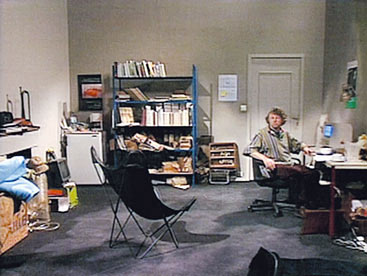
Born in 1954 in Colombus, Ohio (US)
Lives and works in New York (US) and Berlin (DE)

1998-1999
Video installation, colour, sound
Production Le Fresnoy, Studio national des arts contemporains, Tourcoing (FR)
Dimensions variables
Year of Purchase: 2004
Judith Barry has been working since the mid-1970s at deconstructing perceptual and anthropological phenomena, notably in video installations requiring extra sharp sight and /or some physical intervention. Her field of investigation crosses gender issues with the processes involved in visual and bodily memorization. Voice off comes as a double video projection in which two image surfaces are placed back to back and leave the viewer to circulate between the two through a gap in the screen. What this installation achieves is a mise en abyme of a precise figure of film rhetoric: shot and counter shot. Despite the ellipse involved in the nar¬ration, the installation’s sounds and pictures respond to a specific diagetics. On the one side, the main female character, along with some men and other women, walk in a fog-filled scene, conversing, soliloquizing, singing, or talking on the phone. On the other side of the screen, a man alone seems to be increasingly obsessed by voices he can hear coming from the wall of the room he is in, until he decides to knock it down. We then see him pass into the space next-door where the action has suddenly stopped. The system of perception thus enables the story to be reconstructed in whatever way the viewer wishes, taking either the man or the woman’s standpoint (‘His side’ and ‘Her side’, as the two sequences are termed). If any doubt remains as to what is going on (are the man and woman talking to each other over the phone? Is the couple kissing on ‘Her side’ all in one of the characters’ mind?), what is shown here is the power of suggestion and interpretation of the voice in its many effects. How does a voice change when its modes of expression are altered (by speaking a different language, with a succession of English, German and French being spoken on ‘Her side’; or when she sings); how can sound induce effects of visualization and projection of space? Such are the stimuli tried out in Voice off. And this dismantling operation (deconstructing the screen both as a physical object and as the support for our fantasies) also includes a nod in the direction of the conventional cinema and its clichés (amorous seduction among lonely city-dwell-ers, especially when the characters are sexual archetypes). While the installation plays on fascination and the intense pleasure it gives, the voice off is a way of amplifying the male/female confron¬tation. This is what the denudation of the cinema voice ultimately brings here, a critical celebration, unless once again it is the other way round …
Frédéric Maufras